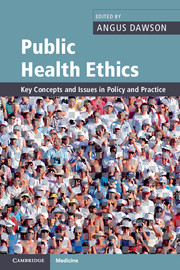3 - Selective reproduction, eugenics and public health
Published online by Cambridge University Press: 05 July 2011
Summary
Introduction
In the wake of Nazi barbarities associated with eugenics, it has become impolitic to speak openly about improving population health and well-being by trying to influence the kinds of people who will be born. But is this goal in fact ethically unacceptable if dissociated with other immoral features of many historical eugenics programs?
(Wikler and Brock, 2007: 87)This question, posed in a recent paper by Wikler and Brock, is the main concern of my chapter. Given recent and impending developments in reproductive and genetic technologies, it is likely that intervening before birth, before embryo-implantation, or even before conception, to alter the composition of future populations, will become an increasingly effective and cost-effective strategy for improving public health. In essence, ensuring that healthier future people are born, and conversely that unhealthier (possible) people are not born, may be a better way of delivering improved public health than the more usual biomedical and environment methods. Or even if it is not a better way, it may nonetheless be a useful addition to public health policy's ‘toolbox’.
The first part of this chapter deals with a number of conceptual or definitional issues, all of which concern, in one way or another, the relationship between selective reproduction and public health. The second part of the chapter considers what I shall term eugenics arguments against using selection, ultimately concluding that worries about the ‘spectre’ of eugenics do not give us strong enough reasons to avoid using selective reproduction to achieve public health goals.
- Type
- Chapter
- Information
- Public Health EthicsKey Concepts and Issues in Policy and Practice, pp. 48 - 66Publisher: Cambridge University PressPrint publication year: 2011



